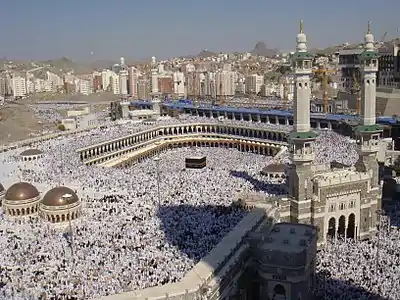Abbasid architecture
Abbasid architecture developed in the Abbasid Caliphate between 750 and 945, primarily in its heartland of Mesopotamia. The Abbasids inherited Persian architectural traditions in Mesopotamia, and were later influenced by Central Asian styles. They evolved distinctive styles of their own, particularly in decoration of their buildings. While the Abbasids lost control of large parts of their empire after 870, their architecture continued to be copied by successor states in Iran, Egypt and North Africa.

Historical background
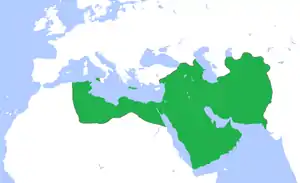
In 750 the Abbasids seized power from the Umayyad rulers of the Arab empire, who lost all their possessions apart from Spain.[1] The Abbasid caliphs based in what is now Iraq ruled over Iran, Mesopotamia, Arabia and the lands of the eastern and southern Mediterranean. The period between 750 and 900 has been described as the Islamic Golden Age.[2] Where the Umayyads had typically reused pre-Islamic buildings in the cities they had conquered, by the Abbasid era many of these structures required replacement. The spread of Muslim beliefs had also brought changes in needs. The Abbasids had to build masjid and palaces, as well as fortifications, houses, commercial buildings and even facilities for racing and polo matches.[3] They upgraded the pilgrim road from Baghdad and Kufa to Mecca, levelled the surface and built walls and ditches in some areas, and built stations for the pilgrims with rooms and a mosque in which to pray.[3]
In 762 the caliph al-Mansur founded a new capital of Baghdad on the Tigris, which soon grew to one of the largest cities in the world. In 836 the caliph al-Mu'tasim transferred the capital to Samarra. The Abbasids began to lose control over the outlying parts of the empire, with local dynasties gaining effective independence in Khorasan (Samanids) in eastern Iran, Egypt (Tulunids) and Ifriqiya (Aghlabids). The caliph al-Mu'tamid, by now the effective ruler only of Iraq, moved his capital back to Baghdad in 889. In 945 the Buyids, followers of Shia Islam, became effective rulers as amirs, while the Abbasid caliphs retained their nominal title. With Caliph al-Nasir (1179-1225) the Abbasids once again gained control of Iraq, but the sack of Baghdad by the Mongols in 1258 brought the Abbasid caliphate to an end.[1]
Origins
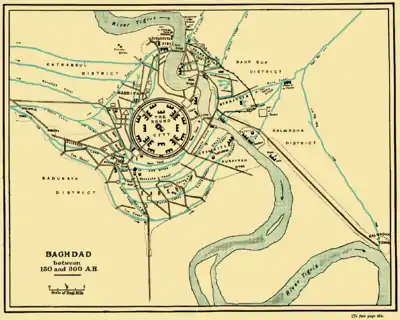
Early Abbasid architecture was very similar to the architecture of the Sassanid Empire, as exemplified by the Palace of Ukhaidhir. It used the same techniques, the same materials of mud brick, baked brick and rough stone blocks set in mortar, and followed Sassanian designs.[1] Stone is rare in the central and southern alluvial plains that formed the heartland of Abbasid territory, so many of the buildings were of mud-brick, faced with plaster and frequently repaired or rebuilt. Sometimes fired brick was used.[3]
When the caliph al-Mansur built the round city of Baghdad, called Madinat al-Salam, which contained the caliphal palace, mosque and administrative buildings, he may have been following earlier traditions such as the round city of Gur built by Ardashir I (r. 224-241) at Firuzabad.[3]
With the conquest of Central Asia, the influence of Soghdian architecture increased. In Samarra the stucco and wall paintings are similar to that of the palaces of Panjakent in what is now Tajikistan. Later, in the 12th and 13th centuries, architecture in the lands ruled by the Abbasids became dominated by Seljuk architecture.[1]
Innovations
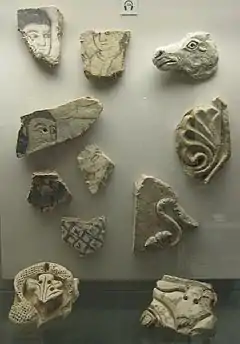
Abbasid cities were laid out on huge sites. The palaces and mosques of Samarra sprawled along the shores of the Tigris for 40 kilometres (25 mi). To match the scale of the sites, monumental buildings were erected, such as the huge spiral minarets of the Abu Dulaf Mosque and the Great Mosque of Samarra, which had no counterparts elsewhere.[1] The two-centered pointed arch and vault had appeared before the Abbasids took power, but became standard in Abbasid architecture, with the point becoming more prominent.[3] The first fully developed example of the four-centered pointed arch was at the Qasr al-'Ashiq, built between 878 and 882.[4]
Three new types of stucco decoration were developed in Samarra and rapidly became popular elsewhere.[1] The first two styles may be seen as derivative from Late Antique or Umayyad decorative styles, but the third is entirely new. Style C used molds to create repeating patterns of curved lines, notches, slits, and other elements. The fluid designs make no use of traditional vegetal, geometric or animal themes.[5] The stucco work was sometimes colored in red or blue, and sometimes incorporated a glass mosaic.[6] The patterns cut into the stucco surface at an angle. This is the first and purest example of the arabesque.[5] It may represent a deliberate attempt to make an abstract form of decoration that avoids depiction of living things, and this may explain its rapid adoption throughout the Muslim world.[7]
Characteristics
Typical features of the more important buildings included massive round piers and smaller engaged columns.[8] 9th century Abbasid architecture had foliate decorations on arches, pendant vaults, muqarnas vaults and polychrome interlaced spandrels that became identified as typical of "Islamic" architecture, although these forms may have their origins in Sassanian architecture. Thus the fronting arch of the Arch of Ctesiphon was once decorated with a lobed molding, a form copied in the palace of al-Ukhaidar.[9]
Palaces
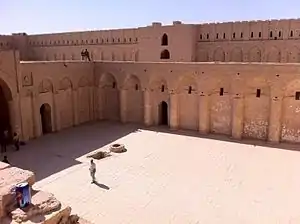
The earliest surviving Abbasid palace, built around 775, is the al-Ukhaidir Fortress. It has a plan derived from earlier Sasanian and Umayyad palaces.[10] The palace lies in the desert about 180 kilometres (110 mi) to the south of Baghdad.[11] It is rectangular in shape, 175 by 169 metres (574 by 554 ft), with four gates. Three are in half-round towers that protrude from the wall, and one in a rectangular recess in the wall. Inside there is a vaulted entrance hall, a central court, an iwan (hall) open to the court opposite the entrance hall, and residential units.[10] Sasanian techniques persist in the construction of vaults with pointed curves using rubble and mortar faced with brick and stucco, blind arches as decorations for large wall surfaces, and long vaulted halls with recesses behind arches supported by heavy pillars. Verbal descriptions indicate that palaces in Baghdad had similar layout, although on a larger scale.[12]
Palaces at Samara such as al-'Ashiq and al-Jiss, built around 870, display polylobed moldings carved deeply into the intrados of the arches, giving the appearance of a foliate arch.[13] Floors were sometimes of marble, more often tiled.[4] The reception rooms of palaces at Samarra had carved or molded stucco dados decorating the lower part of the walls, and stucco also decorated door frames, wall-niches and arches, in three distinct styles.[4] Other palaces that have been excavated often have a domed central chamber surrounded by four iwans facing outward.[14]
The only Abbasid palace left in Baghdad is located in the Al-Maiden neighborhood overlooking the Tigris.[15] The palace was erected under Caliph al-Nasir li-Din Allah (1179-1225). The palace stands two stories high and contains a central courtyard and an iwan with a brick ceiling and facade. Excavations and restoration efforts show that it most likely functioned as a school rather than a palace. Some scholars believe that it is the Sharabiya School, a school for Islamic theology built in the 12th century.[16] The palace structure and design shares close similarities with Al-Mustansiriya University. Certain parts of the palace were reconstructed by the State Establishment of Antiquities and Heritage, including restoration of the great Iwan and the adjacent facades.[17]
Mosques
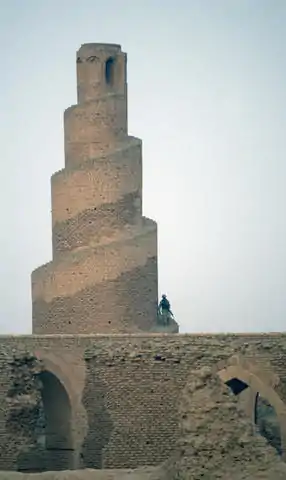
The Abbasid continued to follow the Umayyad rectangular hypostyle plan with arcaded courtyard and covered prayer hall. They built mosques on a monumental scale using brick construction, stucco ornament and architectural forms developed in Mesopotamia and other regions to the east.[19] The earliest mosque was built by al-Mansur in Baghdad, since destroyed. The Great Mosque of Samarra built by al-Mutawakkil was 256 by 139 metres (840 by 456 ft). A flat wooden roof was supported by columns. The mosque was decorated with marble panels and glass mosaics.[10] The prayer hall of the Abu Dulaf mosque at Samarra had arcades on rectangular brick piers running at right angles to the qibla wall. Both of the Samarra mosques have spiral minarets, the only examples in Iraq.[10] A mosque at Balkh in what is now Afghanistan was about 20 by 20 metres (66 by 66 ft) square, with three rows of three square bays, supporting nine vaulted domes.[4] Other surviving Abbasid mosques are the late ninth-century Mosque of Ibn Tulun in Cairo, the Tarik Khane of Damghan (Iran) of between 750-89. and the ninth-century Masjid-I-Tarikh in Balkh, Afghanistan.[20]
Other buildings
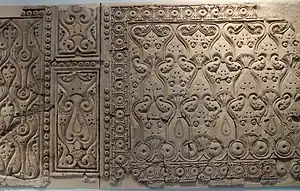
Houses were often built in blocks.[14] Most houses seem to have been two story. The lower level was often sunken into the ground for coolness, and had vaulted ceilings. The upper level had a timber ceiling and a flat terraced roof that provided living space in summer nights. Houses were built around courtyards, and had featureless exteriors, although they were often elaborately decorated inside.[6] There are no traces of windcatchers, which later became common Islamic architectural features. Most of the houses had latrines and facilities for cold-water bathing.[14]
The Abbasids also undertook public works that included construction of canals in Samarra and of cisterns in Tunisia and Palestine. The Nilometer at Fustat, near modern Cairo, built in 861, has elaborate and ornate stonework and discharging arches.[21]
Decoration
The three types (Styles A, B, and C) of stucco decoration best exemplified, and perhaps developed, in Abbasid Samarra were quickly imitated elsewhere and Style C, which itself remained common in the Islamic world for centuries, was an important precursor to fully developed arabesque decoration.[22] The Tulinids in Egypt built copies of Abbasid buildings on Cairo.[2] The Ahmad ibn Tulun Mosque, built in Fustat near Cairo in 876-879, combines Umayyad and Abbasid structural and decorative features.[23] It is the only mosque outside Iraq to have a spiral minaret.[10]
The layout of the Fatimid city of Al-Mansuriya in Ifriqiya founded in 946 was circular, perhaps in imitation of Baghdad. The choice of layout may have been a deliberate challenge to the Abbasid Caliphate.[24] The Fatimid architecture of Ifriqiya and Egypt followed Abbasid styles, as shown by the Great Mosque of Mahdiya and the Azhar Mosque in Cairo.[25] Even Umayyad buildings of the Iberian peninsula show Abbasid influence.[2] Nine-domed mosques have been found in Spain, Tunisia, Egypt and Central Asia.[26] More recent buildings sometimes follow Abassid architectural styles, such as the 19th century Hamoudi Mosque in Djibouti.
Examples
 Bay'ah Mosque is the mosque outside Mecca in Saudi Arabia. It was built on the order of Abbasid Caliph Al-Mansur in 761/2 at the site of al-Bay'ah, i.e. the place where the Prophet Muhammad met with the Ansar (the supporters), and they took the pledge ('bay'ah). this Mosque is an great example of Abbasid architecture.
Bay'ah Mosque is the mosque outside Mecca in Saudi Arabia. It was built on the order of Abbasid Caliph Al-Mansur in 761/2 at the site of al-Bay'ah, i.e. the place where the Prophet Muhammad met with the Ansar (the supporters), and they took the pledge ('bay'ah). this Mosque is an great example of Abbasid architecture.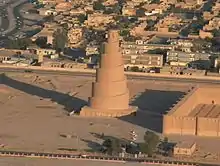 Built by Caliph Al-Mutawakkil. Spiral minaret of the Great Mosque of Samarra, Iraq, inherits the unique architecture of "Minar" in Firuzabad
Built by Caliph Al-Mutawakkil. Spiral minaret of the Great Mosque of Samarra, Iraq, inherits the unique architecture of "Minar" in Firuzabad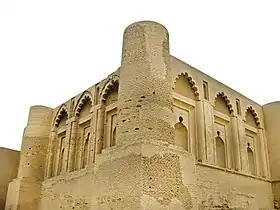 Qasr al-'Ashiq (قصر العاشق) is a historical palace of the early Abbasid era, located near the city of Samarra. The palace was commissioned under the 15th Abbasid caliph Al-Mu'tamid, and construction took place during 877–882 AD.
Qasr al-'Ashiq (قصر العاشق) is a historical palace of the early Abbasid era, located near the city of Samarra. The palace was commissioned under the 15th Abbasid caliph Al-Mu'tamid, and construction took place during 877–882 AD.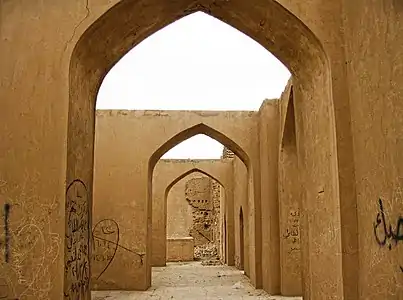 View of the Corridor of Qasr al-'Ashiq palace
View of the Corridor of Qasr al-'Ashiq palace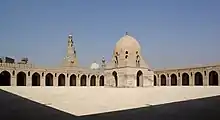 Mosque of Ibn Tulun is an example of Abbasid architecture built by Abbasid Governor Ahmad ibn Tulun
Mosque of Ibn Tulun is an example of Abbasid architecture built by Abbasid Governor Ahmad ibn Tulun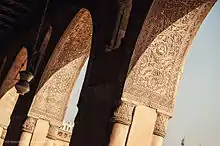 Abbasid Geometric arch decorations
Abbasid Geometric arch decorations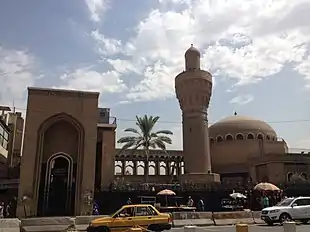 Al-Khulafa Mosque built by Abbasid Caliph Al-Muktafi, this Mosque is an great example of Abbasid architecture
Al-Khulafa Mosque built by Abbasid Caliph Al-Muktafi, this Mosque is an great example of Abbasid architecture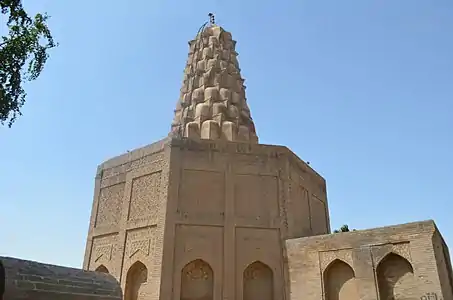 Zumurrud Khatun Mosque and Mausoleum The site was built by Sitt Zubayda also known as Zumurrud Khatun in 1202, who was mother of the 34th Abbasid Caliph Al-Nasir, and wife of the 33rd Abbasid Caliph Al-Mustadi
Zumurrud Khatun Mosque and Mausoleum The site was built by Sitt Zubayda also known as Zumurrud Khatun in 1202, who was mother of the 34th Abbasid Caliph Al-Nasir, and wife of the 33rd Abbasid Caliph Al-Mustadi Al-Sarai Mosque was first laid by 34th Abbasid Caliph Al-Nasir, this Mosque is an example of later Abbasid period Architecture
Al-Sarai Mosque was first laid by 34th Abbasid Caliph Al-Nasir, this Mosque is an example of later Abbasid period Architecture.jpg.webp) Mustansiriya University is an example of later Abbasid period architecture
Mustansiriya University is an example of later Abbasid period architecture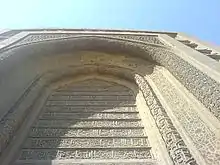 Mustansiriya University, main entrance is the example of Abbasid Geometric arch decorations
Mustansiriya University, main entrance is the example of Abbasid Geometric arch decorations Abbasid-period buildings being excavated at the Givati Parking Lot dig, Jerusalem. Palestine was neglected by the Abbasids, and was mainly a society of peasant farmers.[27]
Abbasid-period buildings being excavated at the Givati Parking Lot dig, Jerusalem. Palestine was neglected by the Abbasids, and was mainly a society of peasant farmers.[27]
References
- Petersen 2002, p. 1.
- Bloom & Blair 2009, p. 78.
- Bloom & Blair 2009, p. 79.
- Bloom & Blair 2009, p. 82.
- Ettinghausen, Grabar & Jenkins 2001, p. 58.
- Bowen 1928, p. 22.
- Ettinghausen, Grabar & Jenkins 2001, p. 59.
- Petersen 2002, p. 32.
- Tabbaa 2002, p. 138.
- Bloom & Blair 2009, p. 80.
- Ettinghausen, Grabar & Jenkins 2001, p. 53.
- Ettinghausen, Grabar & Jenkins 2001, p. 54.
- Tabbaa 2002, p. 139.
- Bloom & Blair 2009, p. 81.
- JPC Inc 1984, p. 47.
- Michell 1978, p. 247.
- Al-Janab 1982, p. 68-72.
- جامع ابو دلف. Masajed Iraq. Retrieved January 4, 2018.
- Ettinghausen 1987, pp. 75-125.
- Hoag 1987, pp. 23-31.
- Ettinghausen, Grabar & Jenkins 2001, p. 55.
- Bloom & Blair 2009, p. 57-59.
- Kuban 1974, p. 20.
- The Art of the Fatimid Period.
- Ende & Steinbach 2010, p. 839.
- Bloom & Blair 2009, p. 83.
- Rast 1992, p. 198.
Sources
| Wikimedia Commons has media related to Abbasid architecture. |
- Al-Janab, Tariq Jawad (1982). Studies In Mediaeval Iraqi Architecture. Baghdad: Republic of Iraq. Iraq: Ministry of Culture and Information State Organization of Antiquities and Heritage.CS1 maint: ref=harv (link)
- Bloom, Jonathan M.; Blair, Sheila (2009). The Grove Encyclopedia of Islamic Art & Architecture. Oxford University Press. ISBN 978-0-19-530991-1. Retrieved 2013-03-15.CS1 maint: ref=harv (link)
- Bowen, Harold (1928). The Life and Times of 'Alí Ibn 'Ísà: The Good Vizier. CUP Archive. p. 22. GGKEY:XCFF2WB6YR1. Retrieved 2013-03-16.CS1 maint: ref=harv (link)
- Ende, Werner; Steinbach, Udo (2010-04-15). Islam in the World Today: A Handbook of Politics, Religion, Culture, and Society. Cornell University Press. ISBN 978-0-8014-6489-8. Retrieved 2013-03-16.CS1 maint: ref=harv (link)
- Ettinghausen, Richard (1987). The Abbasid Tradition:In The Art and Architecture of Islam 650-1250. New Haven: Yale UP. pp. 75–125.CS1 maint: ref=harv (link)
- Ettinghausen, Richard; Grabar, Oleg; Jenkins, Marilyn (2001). Islamic Art and Architecture: 650-1250. Yale University Press. p. 53. ISBN 978-0-300-08869-4. Retrieved 2013-03-16.CS1 maint: ref=harv (link)
- Hoag, John (1987). "Abbasid Architecture". Islamic Architecture. NY: Rizzoli.CS1 maint: ref=harv (link)
- JPC Inc (1984). usafa: Study on Conservation and Redevelopment of Historical Centre of Baghdad City/Republic of Iraq. Amanat al Assima. Japan.CS1 maint: ref=harv (link)
- Kuban, Dogan (1974). Muslim Religious Architecture. BRILL. ISBN 978-90-04-03813-4. Retrieved 2013-03-15.CS1 maint: ref=harv (link)
- Michell, George (1978). Architecture of the Islamic World; Its History and Social Meaning. London: London: Thanes & Hudson.CS1 maint: ref=harv (link)
- Petersen, Andrew (2002-03-11). Dictionary of Islamic Architecture. Routledge. ISBN 978-0-203-20387-3. Retrieved 2013-03-15.CS1 maint: ref=harv (link)
- Rast, Walter E. (1992-11-01). Through the Ages in Palestinian Archaeology: An Introductory Handbook. Continuum International Publishing Group. p. 198. ISBN 978-1-56338-055-6. Retrieved 2013-03-16.CS1 maint: ref=harv (link)
- Tabbaa, Yasser (2002). The Transformation of Islamic Art During the Sunni Revival. I.B.Tauris. ISBN 978-1-85043-392-7. Retrieved 2013-03-15.CS1 maint: ref=harv (link)
- "The Art of the Fatimid Period (909–1171)". Metmuseum.org. Retrieved 11 March 2013.
